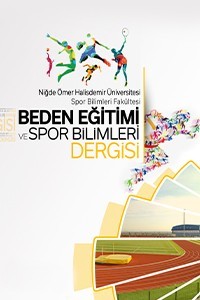BEDEN EĞİTİMİ PROGRAMLARINDA VERİLEN KİCKBOKS DERSLERİ KOLLUĞUN SAVUNMA SPORU İÇİN MOTİVASYON SAĞLIYOR MU?
Kolluk Savunma sporu, Kickboks, Spor, Motivasyon., Kolluk Savunma sporu, Kickboks, Spor, Motivasyon.
DO KICKBOXING LESSONS GIVEN IN PHYSICAL EDUCATION PROGRAMS MOTIVATION FOR LAW ENFORCEMENT DEFENSE SPORTS?
Kolluk Savunma sporu, Kickboks, Spor, Motivasyon.,
___
- Öztürk E. (2022). Ters yüz edilmiş sınıf modeli uygulamasının jandarma ve sahil güvenlik akademisi fakülte öğrencilerinin kolluk savunma ve müdahale teknikleri dersine yönelik farklı parametreler açısından incelenmesi. Doktora Tezi, Ankara Üniversitesi, Sağlık Bilimleri Enstitüsü. Ankara.
- Jandarma ve Sahil Güvenlik Akademisi (JSGA). (2020). Beden eğitimi ve kolluk savunma teknikleri. JSGA Basım Evi Müdürlüğü: Ankara.
- Calmet M., Miarka B., Franchini E. (2010). Modeling of grasps in judo contests. International Journal of Performance Analysis in Sport. 10(3), 229-24.
- Buschbacher RM., Shay T. (1999). Martial arts. Physical Medicine and Rehabilitation Clinics of North America.
- Ziyagil MA. (2008). Türkiye Kick Boks Federasyonu Spor Bilimleri Dergisi. 1(1), 13-22.
- Ouergui İ., Hüseyin N., Franchini E., Bouhlel E. (2013). Üst düzey kickboks maçlarının teknik ve taktiksel analizi. Uluslararası Sporda Performans Analizi Dergisi. 13(2), 294-309.
- Casolino E., Cortis C., Lupo C., Chiodo S., Mingnati C. (2012). Physiological vs physiological evaluation in teekwando elite athletes. International Journal of Sports Physiology and Performance. 26(6), 1489-1495.
- Skelton DL., Glynn MA., Berta SM. (1991). Aggressive behavior as a function of taekwondo ranking. Perceptual and Motor Skills. 5(72), 179-182.
- Fuller R. (1988). Martial arts and psychological health. British Medical Psychology. 6(1), 317-332.
- Toskovic NN. (2001). Alterations in selected measures of mood with a single bout of dvnamic Taekwondo exercise in college-age students. Perceptual and Motor Skills. 92, 1031-1038.
- Zazryn TR., Finch CF., McCrory P. (2003). 16 year study of injuries to professional kickboxers in the state of victoria. British Journal of Sports Medicine. 37(5), 448-451.
- Jackson K., Bigelow KE, Cooper C., Merriman H. (2012). A group kickboxing program for balance, mobility and quality of life in ındividuals with multiple sclerosis: a pilot study. The Journal of Neurologic Physical Thereapy. 36, 131- 137.
- Chaabene H., Hachana Y., Franchini E., Mkaouer B., Chamari K. (2012). Physical and physiological profile of elite karate athletes. Sports Medicine. 42(10), 829-843.
- Yoon J. (2002). Physiological profiles of elite senior wrestlers. Sports Medicine. 32, 225-33.
- Kordi R., Maffulli N., Wroble RR., Wallace WA. (2009). Combat Sports Medicine. Springer Science Business Media.
- Türkiye Kick Boks Federasyonu. (2022). Kurumsal tarihçe. https://kickboks.gov.tr/sayfa/tarihce.html. [Erişim tarihi: 20.12.2022].
- Bycura D., Darst PW. (2001). Motivating middle school students: A health club approach. Journal of Physical Education, Recreation & Dance. 72(7), 24-29.
- Pıcone AD., Ione T., Rıgon M., Alıbertı S. (2021). The importance of balance with the prescriptive teaching in kickboxing. Journal of Human Sport & Exercise. 16, 2021- 2030.
- Silva A., Quaresma AM. (2019). Motivation and martial arts and combat sports participation: a study protocol. Revista de Artes Marciales Asiaticas. 14(2), 34-36.
- Soyer F., Can Y., Güven H., Hergüner G., Bayansalduz M., Tetik B. (2010). Sporculardaki başarı motivasyonu ile takım birlikteliği arasındaki ilişkinin incelenmesi. Uluslararası İnsan Bilimleri Dergisi. 7(1), 225-239.
- Acar S. (2009). Web destekli performans tabanlı öğrenmede ARCS motivasyon stratejilerinin öğrencilerin akademik başarılarına, öğrenmenin kalıcılığına, motivasyonlarına ve tutumlarına etkisi. Yayınlanmamış Doktora Tezi, Gazi Üniversitesi Eğitim Bilimleri Enstitüsü, Ankara.
- Slimani M., Chaabene H., Miarka B., Franchini E., Chamari K., Cheour F. (2017). Kickboxing review: anthropometric, psychophysiological and activity profiles and injury epidemiology. Biology of Sport. 34(2), 185-196.
- Kaya E. (2019). Investigation of motivation levels of ındividuals doing fitness and kickbox for recreative activity purpose in terms of some variables. Journal of Education and Training Studies. 7(10), 11-18.
- Stefanek KA. (2004). An exploration of participation motives among collegiate taekwondo participants. Eugene, OR, Kinesiology Publications, University of Oregon.
- Weiser M., Kutz I., Klitz SJ., Weiser D. (1995). Psychotherapeutic aspects of the martial arts. American Journal of Psychotherapy. 49, 118-127.
- Toskovic NN., Blessing D., Williford HN. (2002). The effect of experience and gender on cardiovascular and metabolic responses with dynamic tae kwon do exercise. Journal of Strength and Conditioning Research. 16, 278-285.
- Karaman B. (2021). Beden eğitimi ve spor dersinde uygulanan ters-yüz öğrenme modelinin öğrencilerin bilgi, beceri ve motivasyon düzeylerine etkisi. Yüksek Lisans Tezi, Pamukkale Üniversitesi, Eğitim Bilimleri Enstitüsü. Denizli.
- Bingöl E., Yıldız SM. (2020). Sporda motivasyon, kendinle konuşma ver performans ilişkisi. LAP Lambert Acedemic Publishing.
- Pintrich PR, Schunk DH. (2002). Motivation in education: theory, research, and applications. Prentice Hall: New Jersey.
- Thorkildsen TA, Nicholls JG. (2002). Motivation and the struggle to learn: responding to fractured experiences. Allyn and Bacon: Boston, Massachusetts.
- Çoban F. (2017). Farklı spor branşlarındaki üniversite öğrencilerinin dikkat düzeylerinin karşılaştırılması. Yüksek Lisans Tezi, Fırat Üniversitesi, Sağlık Bilimleri Enstitüsü. Elazığ.
- Hidi S., Renninger KA. (2006). The four-phase model of interest development. Educational Psychologist. 41(2), 111-127.
- Cengiz E., Aslan A. (2012). The effect of ARCS motivation model achievement and retention of learning in the unit of systems of our body. Kastamonu Education Journal September. 20(3), 883-896.
- ISSN: 1307-6477
- Yayın Aralığı: Yılda 3 Sayı
- Başlangıç: 2007
- Yayıncı: Niğde Ömer Halisdemir Üniversitesi
SPOR YAPAN VE YAPMAYAN AMPUTE BİREYLERİN ÖZ GÜVEN DÜZEYLERİNİN KARŞILAŞTIRILMASI
Harun BOZKURT, Cihat KORKMAZ, Ökkeş Alpaslan GENÇAY
FİZİKSEL OKURYAZARLIĞIN TANIMI TEMELLERİ VE ÖNEMİ
Hasan Hüseyin ASLAN, Hüseyin ÜNLÜ
Seda YALÇIN, Gökhan YERLİKAYA, Malik BEYLEROĞLU
HOKEY SPORCULARININ SPORTMENLİK DÜZEYLERİNİN İNCELENMESİ
Mehmet Ozan ŞAHİN, Ali YILDIRIM
KADINLARDA ZUMBA EGZERSİZLERİNİN AKUT PSİKOFİZYOLOJİK ETKİLERİ
SPORCU SAĞLIĞINDA YENİ BİR YAKLAŞIM: SPOR DİŞ HEKİMLİĞİ
VOLEYBOL HAKEMLERİNİN İŞ STRES DÜZEYLERİNİN FARKLI DEĞİŞKENLERE GÖRE İNCELENMESİ
